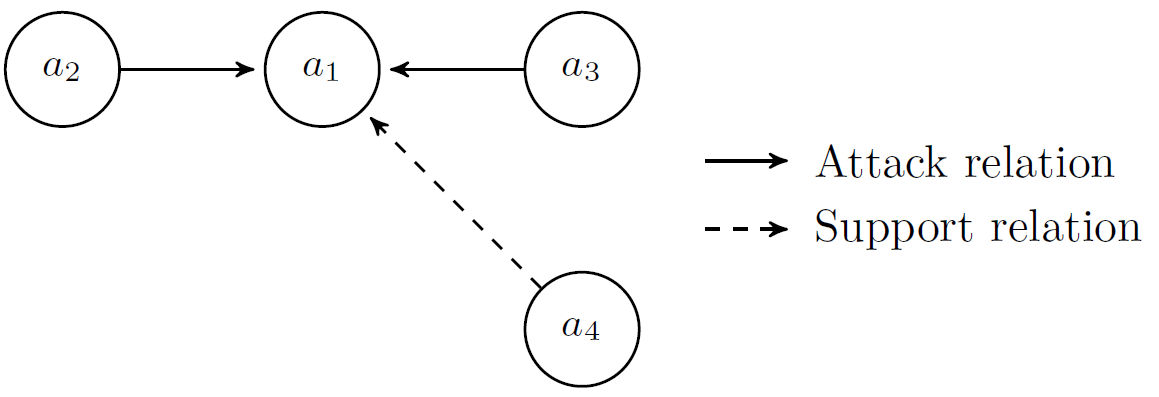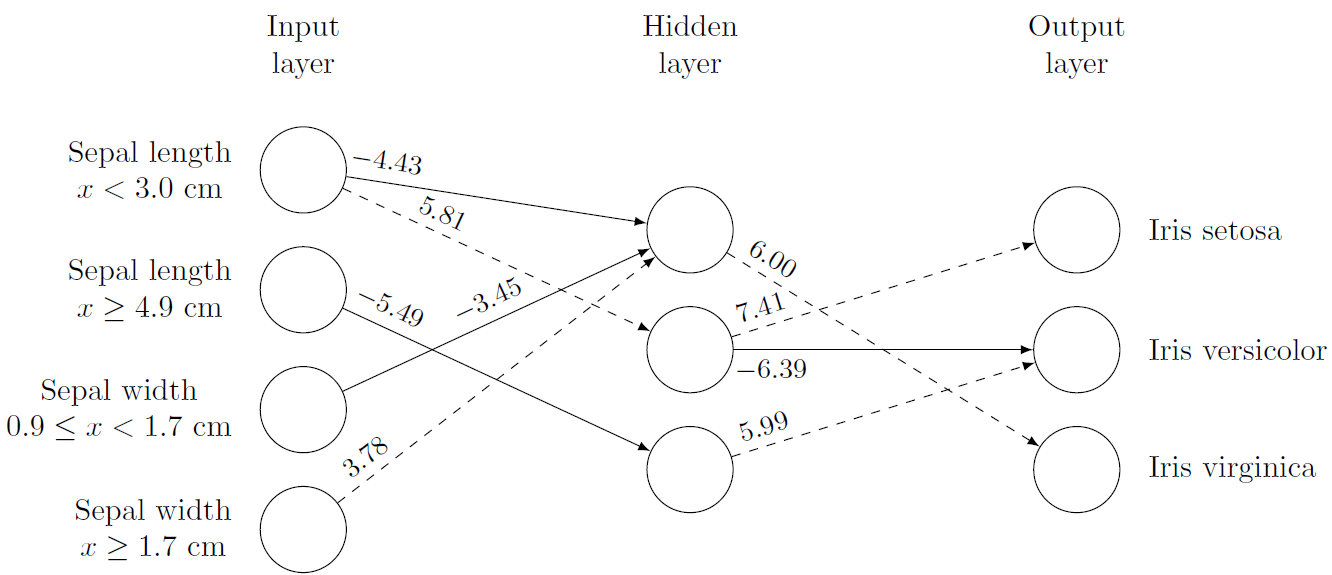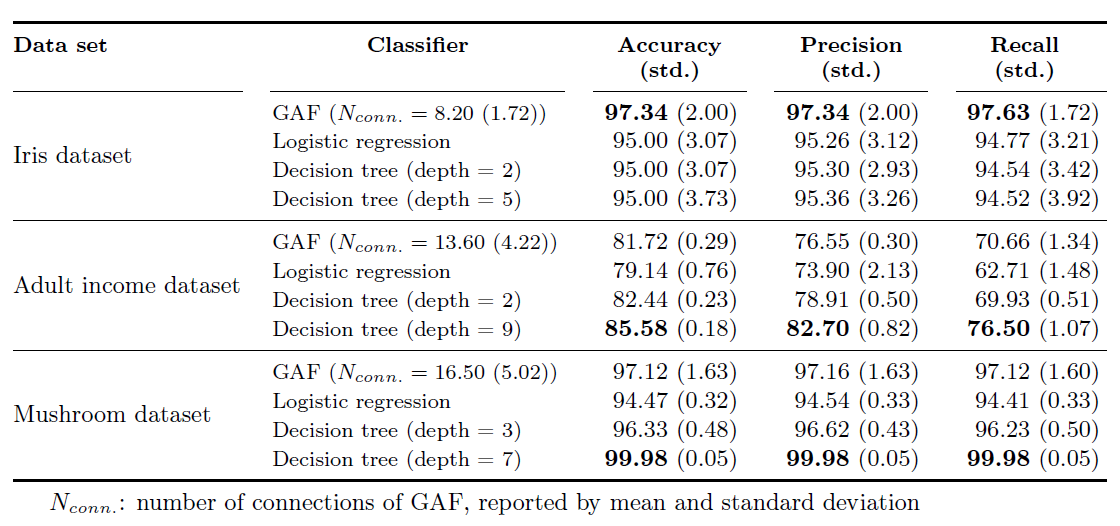Research project on structure learning of Gradual Bipolar Argumentation Graphs (G-BAGs) using Genetic Algorithms.
G-BAGs are implemented in PyTorch as sparse multilayer perceptrons.
Code to reproduce experiments from [1].
An edge-weighted Gradual Bipolar Argumentation Graph (G-BAG) or Gradual Argumentation Framework (GAF) is defined as a quadruple
, where
is a finite set of arguments,
is a set of edges between the arguments,
is a function that assigns a base score
to every argument and
is a function that assign a weight to every edge.
Edges with negative weights are called attack and edges with positive weights are called support relations.
A G-BAG can be graphically represented as a directed graph consisting of nodes that show the arguments and edges that describe the relations between arguments. Attack relations are represented by solid and support relations by dashed edges.
Arguments are evaluated by numerical values, so-called acceptance or strength values. The acceptability of arguments is determined by a semantics which provides a partial function that assigns acceptability degrees to arguments based on their initial base scores and the relations between the arguments. The initial base scores may be seen as the acceptability of an argument without taking support or attack relations into account. The acceptability degree of an argument is typically calculated by a modular update function consisting of an aggregation function and an influence function
.
As shown in [2], a multilayer perceptron (MLP) can be interpreted as a G-BAG when an aggregation function is used that uses summation and an influence function that is similar to the activation function of a neural network. Since only acyclic G-BAGs are considered, they can be seen as sparse MLPs. This allows to perform parameter learning using the usual backpropagation procedure.
The aim is then to use genetic algorithms in order to learn the structure of G-BAGs. Since we are interested in well interpretable G-BAGs to solve classification problems, the fitness function balances sparseness and accuracy of the classifier.
Following packages and libraries are required:
- PyTorch
- SparseLinear
- Matplotlib
- Numpy
- Pandas
- Scikit-learn
- SciPy
- mlxtend
Follow installation instructions and install Pytorch Sparse package before installing SparseLinear.
-
Clone the repo
git clone https://github.com/jspieler/QBAF-Learning.git
-
Install required packages
-
If you use
pipto installSparseLinear, make sure that the definition of the sparsity for user-defined connectivity matrices is correct.
After importing the genetic algorithm, we can simply use it as follows:
from genetic_algorithm import GeneticAlgorithm
import torch
params = {'number_runs': 10, 'population_size': 100, 'number_generations': 20, 'crossover_rate': 0.9, 'mutation_rate': 0.001,
'learning_rate': 3e-2, 'number_epochs': 3000, 'hidden_size': 12, 'number_connections1': 8, 'number_connections2': 6,
'lambda': 0.2, 'patience_ES': 5, 'tolerance_ES': 1e-4, 'elitist_pct': 0.1, 'patience_GA': 5, 'tolerance_GA': 1e-4}
criterion = torch.nn.CrossEntropyLoss()
model = GeneticAlgorithm(input_size=12, output_size=2, selection_method='tournament_selection',
crossover_method='two_point_crossover', mutation_method='flip_mutation', params=params,
loss_function=criterion, show_graph=True)
model.run(X_tr, y_tr, X_val, y_val, X_te, y_te, input_labels=inputs, class_labels=label, file_name=fname)Following methods are implemented:
- Selection:
roulette_wheel_selection,tournament_selection,rank_selection - Crossover:
one_point_crossover,two_point_crossover - Mutation:
flip_mutation,swap_mutation
Detailed examples are provided for the iris, the adult income and the mushroom data set.
The following picture shows an example of a GAF for the iris dataset.
The following table shows the results of GAFs compared to logistic regression and decision trees on the iris, the adult income and the mushroom dataset (test data). The best values are printed in bold. Two decision trees of different depth were used. One, whose best parameter set was determined using sklearn.model_selection.GridSearchCV and another one whose depth was limited to obtain a comparable performance to GAFs. Each of the performance measures is reported by their mean and standard deviation (%) for 10 runs.
Distributed under the MIT License. See LICENSE for more information.
Please contact us for questions.
[1] Spieler, J., Potyka, N., & Staab, S. (2021) - Learning Gradual Argumentation Frameworks using Genetic Algorithms, arXiv preprint arXiv:2106.13585. https://arxiv.org/pdf/2106.13585.pdf
[2] Potyka, N. (2021) - Interpreting Neural Networks as Quantitative Argumentation Frameworks, Thirty-Fifth AAAI Conference on Artificial Intelligence (AAAI 2021): 6463-6470


